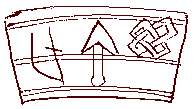Timerevo facts for kids
Timerevo (pronounced Tee-meh-RYO-vo) is an exciting archaeological site in Russia. It is located near a village called Bolshoe Timeryovo. This is about seven kilometers southwest of the city of Yaroslavl. What makes Timerevo special is that it held the largest collection of ancient Arabic coins ever found in Northern Europe. These coins date back to the early Middle Ages.
Contents
What is Timerevo?
An Ancient Trading Post

Timerevo is a large area, about five hectares in size. That's like ten football fields! It did not have any walls or defenses. It seems that a group called the Varangians used this site. The Varangians were Vikings from Scandinavia. They likely managed Timerevo from their main base at Sarskoe Gorodishche, near Rostov.
Even though Timerevo was not right next to a big river like the Volga River, it was very important. The large number of Arabic coins found there shows this. It was a key trading spot for Scandinavians near the important Volga trade route. This route connected Northern Europe with the Middle East.
When Was Timerevo Used?
People first settled at Timerevo in the ninth century. This group was a mix of Norse (Viking) traders and local people. We know this date because of three big collections of dirhams found there. Dirhams were silver coins from the Middle East. These coin hoards were discovered starting in the 1960s.
One collection had about 2,100 coins. Sadly, most of these were spread out before experts could study them. Only seventeen coins from this group are known today. The oldest coin from this hoard dates back to the year 867. Another collection also had more than 2,000 dirhams. This was the biggest group of such coins ever found from Early Medieval Europe. The oldest coin in this collection was made by a ruler named Idris II in the early 800s. Many of these dirhams even had Runic writing carved on them.
Later Life at Timerevo
The site was left empty around the end of the ninth century. But it became active again about 50 years later. During this time, at least 400 burial mounds, called kurgans, were built there. These mounds were for members of a warrior group called a druzhina. People were usually cremated (burned) when they died.
Digging at the site showed many interesting things. There was a lot of Scandinavian pottery. Also, a surprising number of crosses were found. This suggests that many of the Norse people living there had become Christian. Other finds included amber items from the Baltic Sea. A unique cooking roaster was also found. There was even a special sword called a spatha from the Rhine area. It had the name "Ulfberht" on it. A chess piece with a mysterious Runic inscription was also discovered.
Timerevo was finally abandoned in the early 1000s. This happened around the same time that Sarskoe Gorodishche also declined. It was also when the city of Yaroslavl was founded. The newest coin found at Timerevo was made by Bruno II of Friesland. This coin dates from between 1038 and 1057.
Other Nearby Ancient Sites
What Else Was Found Near Yaroslavl?
Many other early medieval sites have been found near Yaroslavl. Each one tells us something important about the past.
- Mikhailovskoe: This site is just north of Yaroslavl. It was explored from the 1800s until 1961. Out of 400 burial mounds dug up there, only a few had Scandinavian items. Most burials were of ordinary Slavs and Merians. These people were buried whole, not cremated.
- Medvezhy Ugol: This site is in downtown Yaroslavl. Its name means "Bear's Nook." It was a smaller settlement, mainly for Merian people.
- Petrovskoe: More recently, 26 burial mounds were found south of the city. Most of these have not been dug up yet. All these sites date back to the mid-tenth century.
Even though only a small number of Scandinavian items have been found, experts have ideas. They think that a "Norman colony" might have existed within the Slavic settlements. This colony would have been a stop for Vikings traveling to the East. Archaeologist Igor Dubov studied the Timerevo settlement in the 1970s. He believes it might have been the main center (or even the capital) of a mysterious place called Arsania. This place was mentioned by an ancient writer named Ibn Hawqal.

